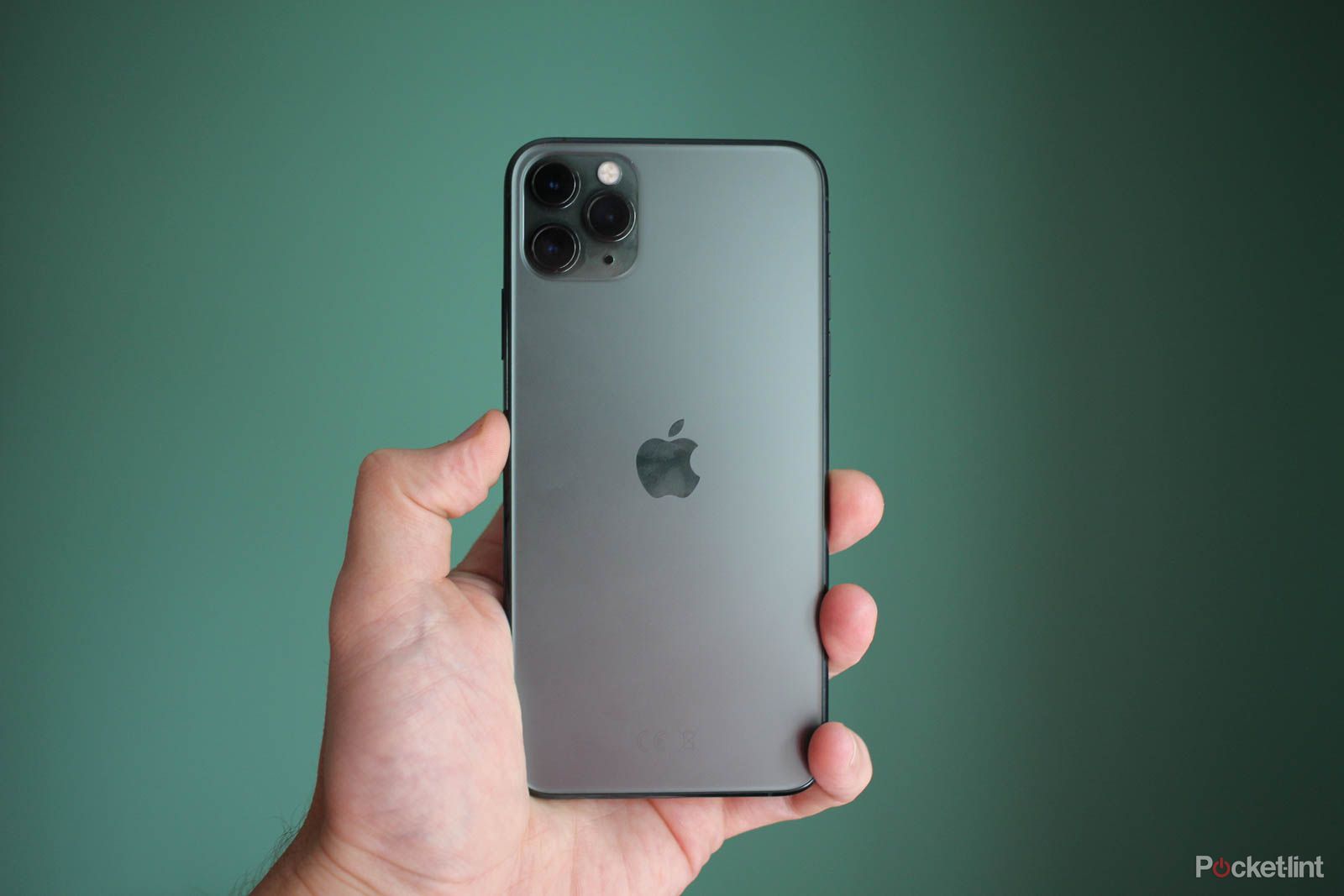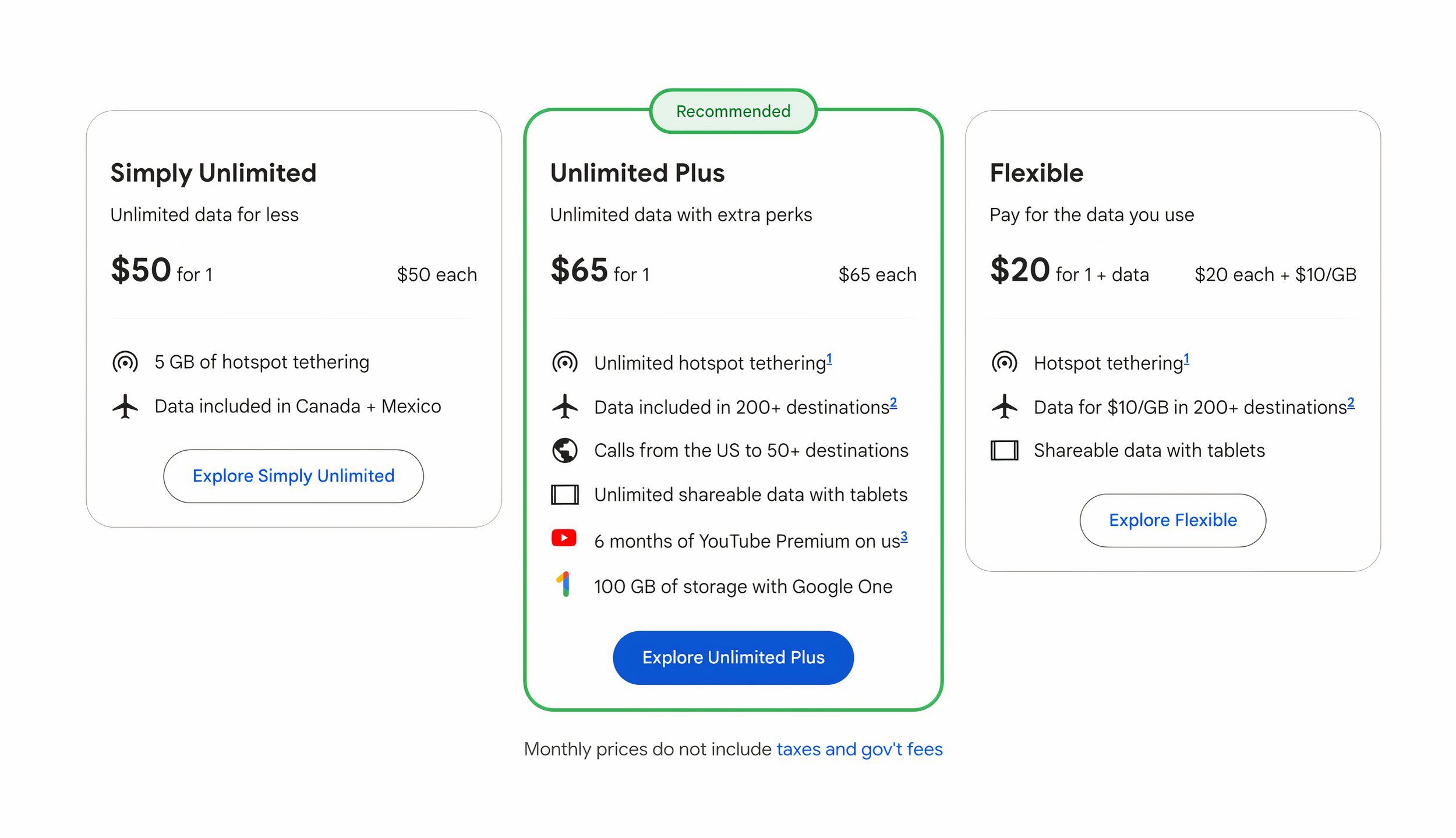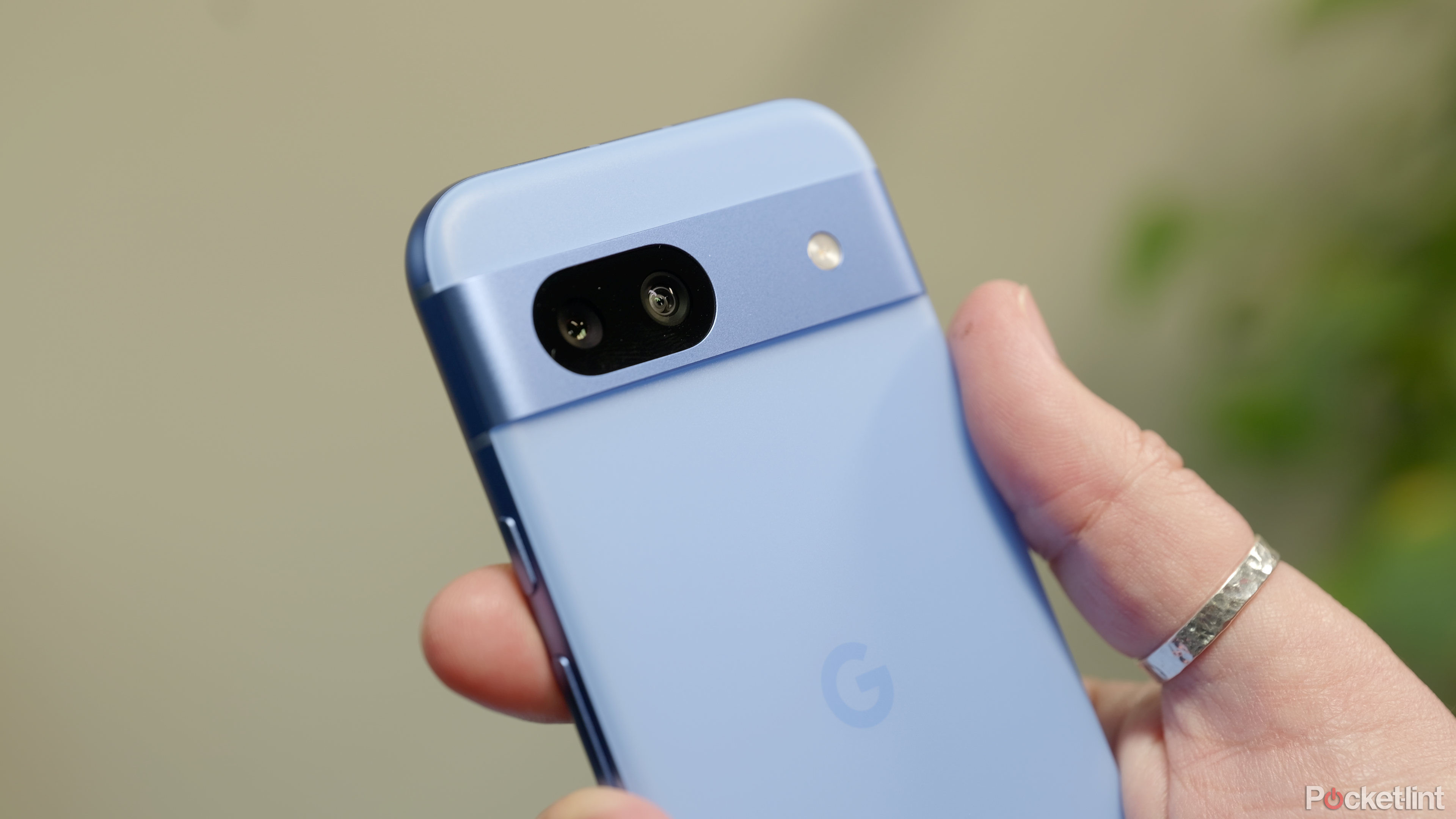Key Takeaways
- Google Fi Wireless simplifies billing with unlimited talk and texting plus flat rate data.
- Google uses T-Mobile’s network, but coverage is about the same due to network consolidation.
- Phones compatible with Google Fi offer different levels of service, but Pixel phones offer the best experience.
Did you know Google is also a cell phone carrier? The company is perhaps best known for its software products like Search, Workspace, Chrome, and, of course, Android, but over the years it’s also made an attempt to offer internet service for that software to run on, too. Google Fiber launched in 2010 to provide wired, fast, fiber-optic connections in your home, and Google Fi Wireless (Project Fi at the time) was created in 2015 for when you’re out and about on your phone.
Google’s goal with Fi is to simplify the cell phone carrier experience, and hopefully make your payments a little bit more affordable in the process, but how it goes about it is interesting. The service launched exclusively for the Nexus 6 and was built around cleverly switching between Sprint and T-Mobile’s cell networks to get customers the best service possible at any given time. It’s since expanded to other Android devices and even iPhones, gaining and losing wireless networks to switch between along the way (US Cellular came in 2016 and went in 2023, Three joined for international coverage).
The Google Fi Wireless of 2024 is different from the Project Fi of 2015, but the basic benefits remain the same. If you’re in the market for 5G and 4G LTE on your phone, especially if you use an Android phone, there’s a good chance you can get a deal by shopping with Google. Here’s everything you need to know about Google Fi Wireless, and how to sign up for the service.
The 9 best Android phones right now
From regenerative AI to stunning cameras, there are plenty of fantastic Android phones available right now.
What is Google Fi?
Life with an MVNO
The novelty of the original Project Fi wasn’t that it was using the networks of carriers like T-Mobile or Sprint (companies like Visible or Mint Mobile do that too), it’s that it moved between them and Wi-Fi to offer you the best experience. Google Fi Wireless, like other Mobile Virtual Network Operators (MVNOs), is technically licensing spectrum from larger companies like T-Mobile, and because T-Mobile customers take priority, Fi-connected phones won’t always get the fastest speeds or performance.
Further complicating things, because of T-Mobile’s purchase of Sprint in 2020 and the consolidation of mobile carriers in general (T-Mobile is now buying a portion of former Fi partner US Cellular), Google Fi Wireless only uses T-Mobile’s network in North America. Performance and speeds are about the same because of the combined network T-Mobile now represents, but it’s worth noting that the network switching gimmick of the original Project Fi no longer applies.
Fi Perks
On top of cheaper 5G and 4G LTE connectivity, Google Fi Wireless also offers streamlined billing. You pay one fee per month for unlimited talk and texting, plus a flat rate per gigabyte of data after that. Fi includes a feature called “Bill Protection” that stops charging you for data once you reach a certain cap, so you always know what to expect each month. Fi also offers international data and calling, though you’ll have to pony up for a more expensive unlimited plan for the best coverage.
Outside of Fi’s base plan, if you pay for one of two unlimited options, you’ll receive some additional base perks like a certain amount of free Wi-Fi hotspot tethering (5GB of high-speed data for the Simply Unlimited plan or unlimited high-speed data for the Unlimited Plus plan), international texts, calls, and data, and 100GB of Google One storage if you use the Unlimited Plus plan. An additional benefit of Google Fi Wireless available to all plans is that Google makes it easy to add additional devices, like a tablet or other gadget, by requesting a data-only SIM card at no additional charge. The device still needs to have a SIM card slot — something that’s becoming increasingly rare — but if it does, all you have to do is order the card, activate it once it arrives, and slot it in, and it can connect to the internet using your plan.
How much does Google Fi cost?
Because a goal of Google Fi Wireless is streamlining billing, there are no real hidden fees in any of the service’s plans. Google Fi Wireless offers three plan options to choose from and how much you pay depends on how many lines you’re looking for. Just like any other carrier, Google will cut you a deal if you can bring your family and friends on board.
Flexible plan
Fi’s “Flexible” plan is the most unique option the service offers, and illustrative of how Google is going about charging for data. Your price could very if you’re also paying off a smartphone while paying for service, but here’s a breakdown of the costs you’ll see in a Flexible single line Fi plan if you brought your own phone:
- For $20 per month, you get unlimited domestic talk and texting, unlimited international texting, and cellular coverage in 200+ countries.
- You can also pay $10 per gigabyte of data – until you hit 6GB ($60) of usage.
- Then, Bill Protection kicks in for your plan. When that happens, data is free for the rest of the monthly billing cycle.
- Once you hit 15GB of total data usage, your speeds are slowed to 256kbps.
- After 15GB, you can choose to pay $10 per gigabyte again for full speed data.
To be clear, the plan only charges you for the data you use, and when you hit a certain amount of data, it’s free for the rest of the month. Also, when you travel internationally, data abroad costs the same as at home.

How to activate Google Fi on your iPhone using an eSIM
Here’s everything you need to know, including how to get started with activation.
Simple Unlimited and Unlimited Plus plans
For a plan with unlimited data you pay $50 per month for a single user, up to a fair usage limit of 35GB. This basic “Simple Unlimited” plan, however, doesn’t include international usage outside the US, Canada, and Mexico, and has just a 5GB hotspot allowance. For that, you’ll need the ‘Unlimited Plus’ plan for $65, which gets you a 50GB fair usage limit for data, unlimited hotspot tethering and 100GB of Google One cloud storage included. Google even throws in a six-month trial of YouTube Premium for Unlimited Plus subscribers for good measure.
For those looking to add additional lines, the per-person monthly price will drop depending on how many people you add. For instance, for two users you pay $18 per person, or for three people you pay $17 per person each month. If you need five or six lines, you pay just $16 per month, per line.
You can find an estimate of Fi bill on Google’s website.
Does Google Fi cover your area?
If you live in a T-Mobile coverage area, then you have nothing to worry about. But you can double-check using this tool.
How does Google Fi work?
Sign up for Fi
Those of you who already have a phone number from a different carrier service that you want to use must first switch carriers and port your phone number. Fortunately, you can sign up for Google Fi online in minutes, and it does a lot of the hard work for you. Some carriers do not allow you to take your number, but Google will check if you can transfer when you sign up. The transfer process usually only takes 15 minutes.
Setting up your device
Next, you need to determine if your phone supports eSIM or if you’ll need to order a Google Fi SIM card. Most new phones support eSIM, so if you purchased your phone in the last seven years or so, there’s a good chance all you’ll need is the Google Fi app. Smartphones you purchased from Google Fi should either support eSIM or arrive with a Google Fi Wireless SIM installed. Otherwise, Google will ship you a free SIM card to put inside your existing phone and activate. To check whether you can have a phone that is “compatible” with Fi, use Google’s checker tool, or see this full list of compatible phones. Most popular Android phones and iPhone models from 5S on up will work with Google Fi Wireless.
Setting up your device from there is as simple as following a few steps in the Google Fi app to pick your plan and activate your device. If you need a physical SIM, you’ll have to wait for it to arrive, but activating it is similarly straightforward. You’ll enter a code into Google Fi Wireless’ website, slot the card in your phone, and be good to go.
8:28

Quirks and all, the Google Pixel 8a is my new favorite mid-range phone
The Pixel 8a is a bit of a conundrum, and my favorite recent mid-range phone launch.
Using Fi
Once you’ve signed up for Fi and are all set up, you can start using your phone like normal. Move around. Travel. You’ll be able to text, call, and use data like normal on T-Mobile or one of Fi’s international partners. Fi will also take any solid connection and route it through a VPN for your safety if you’re using a compatible smartphone. The real plus is if you ever need to switch phones or switch your coverage between phones, doing it is as simple as popping out a SIM card or downloading the Fi app on your new device and tapping through a few prompts.
There is one caveat: Although Google Fi works with most unlocked phones, they won’t be able to do network switching. Some phones will be stuck with the T-Mobile network exclusively (not a huge problem in the U.S. to be clear), and they won’t get Fi’s VPN features. But you do get international roaming, simplified billing, and more. To avoid all this, we recommend using either a “designed” for Fi phone or a Pixel, rather than a random unlocked phone that’s compatible.
International calling
Google Fi works in over 200 countries, with no additional cost for data or texting. Calls cost around $0.20 per min to any number while abroad. (Tip: you pay lower rates when calling over Wi-Fi). Go here full the full list of international rates. You can also call back to the US on Wi-Fi for free. Data used internationally is charged like normal, costing $10 per gigabyte usage, until Bill Protection kicks in.
Managing your account
To manage your account, see your billing, and do just about anything Fi-related, you’ll want to fire up the Fi app for iOS or Android or head to the Google Fi Wireless website.
Which phones work with Google Fi?
As we suggested before, there are two main types of devices that work with Google Fi Wireless. Here is a breakdown of each one and which is best to use.
- Designed for Fi phones: These phones include the Samsung Galaxy S24 series, Moto G 5G (2024), Samsung Galaxy A71 5G and Galaxy Z Flip and Fold 5. See the full list of devices here. They all support Fi, with no limitations. So you get full network switching capabilities, access to the Google Fi VPN service, and more. These phones, if bought direct from Google Fi, either come with a Google Fi Wireless SIM card or the Google Fi app installed.
- Compatible with Fi phones: Google Fi Wireless technically works with any unlocked Android phone and even iPhone, but with some major limitations. They can’t handle Fi’s network switching capabilities, so you’re stuck with T-Mobile, and they don’t get Fi’s always-on VPN feature. These phones may require a Google Fi SIM card that Google will ship to you for free once you sign up for Fi online.
You’ll get the best Google Fi Wireless experience on a Pixel phone, like the new Pixel 8a, or one of the “Designed for Fi” devices, but don’t let that stop you from trying another device if you need to save some money or don’t want to upgrade.
How do iPhones work on Google Fi?
Google Fi Wireless added support for iPhones in 2020, and even four years later the option is still described as a beta. That’s because, even if modern iPhones’ support of eSIM makes using one on the Fi network as simple as downloading an app, there are some notable limitations. Like we previously mentioned, as “Compatible” but not “Designed for Fi,” iPhones are limited to T-Mobile. They also require extra work to set up SMS and MMS texting, though iMessage does work as soon as Fi is set up.
This doesn’t mean that you shouldn’t try and bring your iPhone to Google Fi, but if you’re not in the mood to dig into settings to make everything work how it should, you’d be better off switching phones or staying on your current carrier.
Trending Products

Cooler Master MasterBox Q300L Micro-ATX Tower with Magnetic Design Dust Filter, Transparent Acrylic Side Panel…

ASUS TUF Gaming GT301 ZAKU II Edition ATX mid-Tower Compact case with Tempered Glass Side Panel, Honeycomb Front Panel…

ASUS TUF Gaming GT501 Mid-Tower Computer Case for up to EATX Motherboards with USB 3.0 Front Panel Cases GT501/GRY/WITH…

be quiet! Pure Base 500DX Black, Mid Tower ATX case, ARGB, 3 pre-installed Pure Wings 2, BGW37, tempered glass window

ASUS ROG Strix Helios GX601 White Edition RGB Mid-Tower Computer Case for ATX/EATX Motherboards with tempered glass…













